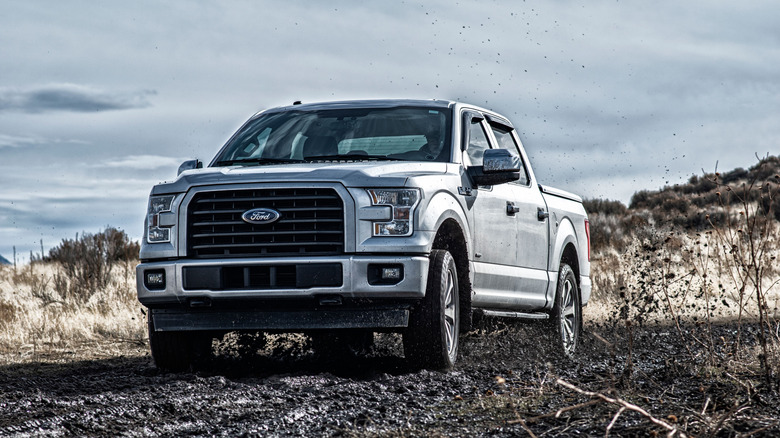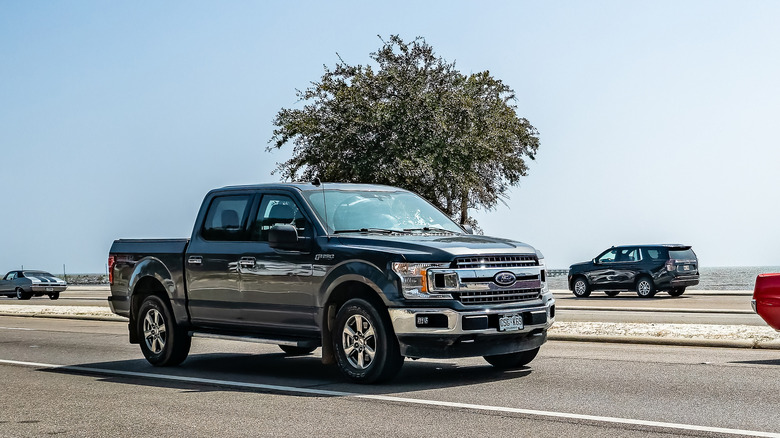What Does 2H And 4H Stand For On A Ford F-150? The Pickup's Drivetrain Modes Explained
At first glance, even to those familiar with the concept of a 4WD system, the nomenclature can sometimes get confusing, and that's just as true with an F-150 as any other. And, with every single light-duty F-series featuring at least optional 4WD since the model line's creation, this concept applies to every generation of F-150, including those equipped with Electronic Shifting on the Fly (ESOF). But as you glance at the transfer case's dial or shifter, you notice that there's a 2H and 4H setting. What do these numbers and letters mean, and what's appropriate to use when? Let's dive deeper, starting with the fundamentals.
Nomenclature-wise, the 2H and 4H units are universal to all modern part-time 4WD systems – they mean two-wheel drive, high-range and four-wheel drive, high-range respectively, with the H settings sometimes called 2-high and 4-high, respectively. There's also a 4L, or four-wheel drive, low-range setting, but this isn't used in daily driving; you would only use that mode in a very specific circumstance. This article, however, focuses solely on the Ford light-duty pickup series, specifically modern F-150s less than 30 years old. However, because most light-duty F-series pickups feature similar driving styles and general quirks, you can also use this as a reference for older models as well.
2H – two-wheel drive, high-range, your perennial setting
2H is the default setting for most 4x4s and 4WD-equipped trucks. In the Ford F-150, what 2H does is disconnect the transfer case's drive to the front axle, rendering your pickup rear-wheel-drive only. At first glance, this sounds like a bad idea, but it's actually far more beneficial to use this mode in 99% of your daily driving. Overuse of your vehicle's 4WD system puts wear on the working components, the parasitic drag saps power and drastically lowers fuel efficiency, and it makes for an even worse turning circle because the axles can't spin at different rates.
This contrasts 4A, or four-wheel drive auto, which is a full-time automated 4WD system in many modern F-series trucks that can be used every day without any issues or additional wear-and-tear. This system keeps both front and rear axles unlocked from one another until it's needed, as opposed to 4H, which either electronically or mechanically links both axles together to operate at the same speed; we'll discuss more how this is done later.
Basically, what you need to know is that 2H or 4A, if your truck is so-equipped, is your everyday-usage setting for this knob or shift lever. For the most part, unless you're in snowy, icy, or flooded conditions, you'll rarely (if ever) find the need to manipulate this setting on pavement or packed dirt. However, some F-series pickups never came with a transfer case to begin with, and thus are RWD-only. If you need additional traction in such a truck, then a good idea is to load up the bed to place more weight over the rear wheels, or remove the weight in muddy conditions to avoid getting bogged down.
4H – four-wheel drive, high-range, for when you can't seem to get a grip
To completely explain this setting, we have to discuss exactly how transfer cases function. In short, a transfer case generally utilizes either a huge bicycle-chain or gear-style linkage to physically connect the engine's power output to both the front and rear axles. Think of it like having a transmission bolted onto the back of your transmission; putting it in 4H effectively engages the front axle like shifting from neutral into gear. ESOF-equipped F-150s utilize this system, so when you turn the dial, this is what happens under the hood.
So when is this setting useful? Well, because 4H physically links both axles together, it means that both axles are no longer able to turn at different speeds. This results in exceptional traction over just about any terrain you're likely to encounter; after all, 4WD systems in F-series came about as a result of a need for traction on unpaved, muddy 1940s farmland, a job it still performs admirably. It can be used at any normal road or highway speed with no issues because the axles generally rotate at the same speed anyway. Most manufacturers and outlets state that anything up to around 55 miles per hour is safe, but at low speeds (less than 15 miles per hour), it's not recommended because, during cornering, this may cause the transfer case to bind. Furthermore, it may put unnecessary strain on the mechanical working components.
Different online sources sometimes state contrary remarks regarding its safe usage, but one universally-agreed upon fact is that 4H is useful on surfaces offering poor traction with frequent wheel-slip, like a snow-covered trail or a sandy beach. In most other cases, however, 2H provides more than sufficient traction for your everyday needs.


